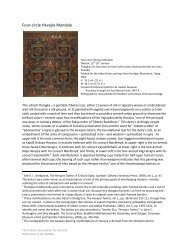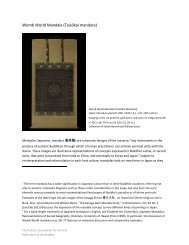Reflections of the Buddha - The Pulitzer Foundation for the Arts
Reflections of the Buddha - The Pulitzer Foundation for the Arts
Reflections of the Buddha - The Pulitzer Foundation for the Arts
You also want an ePaper? Increase the reach of your titles
YUMPU automatically turns print PDFs into web optimized ePapers that Google loves.
Living Things: Buddhist Art in a Building by Tadao Andō<br />
I would like to think <strong>of</strong> [<strong>the</strong> <strong>Pulitzer</strong>] as . . . a space to inspire<br />
visitors and even expand <strong>the</strong>ir consciousness. I wanted to create<br />
a very stimulating place, where works <strong>of</strong> art are not exhibited<br />
merely as specimens but can speak to us as living things.<br />
Tadao Andō, 2000 1<br />
<strong>Reflections</strong> <strong>of</strong> <strong>the</strong> <strong>Buddha</strong> presents twenty-two extraordinary<br />
works <strong>of</strong> Buddhist art dating from <strong>the</strong> second century ce<br />
with three works <strong>of</strong> contemporary art that resonate with<br />
Buddhist <strong>the</strong>mes. All are placed in dialogue with <strong>The</strong><br />
<strong>Pulitzer</strong> <strong>Foundation</strong> <strong>for</strong> <strong>the</strong> <strong>Arts</strong>, <strong>the</strong> building designed by<br />
<strong>the</strong> Japanese architect Tadao Andō, which opened in 2001.<br />
Andō’s philosophy about architecture aligns with some<br />
aspects <strong>of</strong> Buddhist ethics and aes<strong>the</strong>tics, which may<br />
have contributed to his use <strong>of</strong> simple geometry, modest<br />
materials, and natural light. <strong>The</strong> end result is a space that<br />
animates art, and where art enlivens space. In designing<br />
<strong>the</strong> <strong>Pulitzer</strong>, Andō worked with two artists, Ellsworth<br />
Kelly and Richard Serra, from whom Emily <strong>Pulitzer</strong> commissioned<br />
art <strong>for</strong> <strong>the</strong> site: “As a collaboration between<br />
architecture and art right from <strong>the</strong> first stage <strong>of</strong> planning,”<br />
Andō wrote nine years after <strong>the</strong> building opened,<br />
“this was an exceptional task, a pursuit <strong>of</strong> what I believe<br />
to be an ideal art museum.” 2 <strong>Reflections</strong> <strong>of</strong> <strong>the</strong> <strong>Buddha</strong> continues<br />
this reciprocal relationship between art and<br />
architecture in its selection and placement <strong>of</strong> Buddhist<br />
art in Andō’s spaces, allowing <strong>for</strong> an approach to exhibition<br />
narrative that is less historical and more analogous<br />
to poetry than to prose.<br />
<strong>The</strong> Buddhist works in <strong>Reflections</strong> <strong>of</strong> <strong>the</strong> <strong>Buddha</strong><br />
once served in <strong>the</strong>ir original context as aids toward or<br />
visual expressions <strong>of</strong> <strong>the</strong> indescribable state <strong>of</strong> enlightenment<br />
or awakening (Nirvāna), <strong>the</strong> spiritual insight or<br />
awareness that frees a person from <strong>the</strong> cycle <strong>of</strong> birth,<br />
death, and rebirth (samsāra), a concept central to<br />
Buddhism. Nirvāna refers not only to <strong>the</strong> state <strong>of</strong> an enlightened<br />
person after death, but also to <strong>the</strong> state <strong>of</strong><br />
mind “free <strong>of</strong> defilements,” grasped while alive.<br />
Buddhism, one <strong>of</strong> <strong>the</strong> great religions <strong>of</strong> <strong>the</strong><br />
world, is derived from <strong>the</strong> teachings <strong>of</strong> its founder, an<br />
Indian prince named Siddhārtha Gautama, who lived during<br />
<strong>the</strong> fifth century BCE. After witnessing a corpse and<br />
people suffering from frailty and illness, Siddhārtha, at<br />
age twenty-nine, became deeply melancholic and renounced<br />
his wealth. He wandered as an ascetic <strong>for</strong> six<br />
years, until one night he meditated on existence.<br />
Siddhārtha realized that all things are conditional and<br />
impermanent and in a state <strong>of</strong> constant change; all<br />
things are unsatisfying, since any pleasure — physical or<br />
psychological — is fleeting; and all phenomena lack a<br />
permanent self or soul, <strong>the</strong> realization <strong>of</strong> which leads<br />
to selfless, loving kindness and compassion <strong>for</strong> o<strong>the</strong>rs.<br />
Francesca Herndon-Consagra<br />
Through such insights he reached enlightenment. In<br />
later traditions, Siddhārtha became known as <strong>the</strong> <strong>Buddha</strong><br />
Śākyamuni (sage <strong>of</strong> <strong>the</strong> Śākya clan), who became one<br />
<strong>of</strong> many past and future <strong>Buddha</strong>s (Awakened Ones).<br />
<strong>The</strong> Buddhist works in <strong>Reflections</strong> <strong>of</strong> <strong>the</strong> <strong>Buddha</strong><br />
are extraordinarily diverse. Coming from Afghanistan,<br />
China, India, Japan, Korea, Mongolia, Nepal, Pakistan,<br />
and Tibet, <strong>the</strong>y primarily represent two traditions <strong>of</strong><br />
Buddhism that developed in nor<strong>the</strong>rn India and spread<br />
throughout Asia: Mahāyāna (‘Great vehicle’), which began<br />
to flourish in <strong>the</strong> first century ce, and Vajrayāna<br />
(‘Diamond vehicle’), which evolved just prior to <strong>the</strong> sixth<br />
century ce. Vajrayāna is <strong>of</strong>ten seen as a branch <strong>of</strong><br />
Mahāyāna, partially because both believe that many<br />
<strong>Buddha</strong>s and bodhisattvas (enlightened beings who have<br />
postponed Nirvāna to aid o<strong>the</strong>rs in achieving it) exist in<br />
countless worlds. <strong>The</strong>y are also united in an expansive<br />
and optimistic concept that all conscious beings have<br />
inherent <strong>Buddha</strong> natures and are <strong>the</strong>re<strong>for</strong>e capable <strong>of</strong><br />
achieving Nirvāna. Yet each tradition emphasizes a different<br />
journey to <strong>Buddha</strong>hood. Mahāyāna’s takes many eons<br />
to complete, while Vajrayāna’s emphasizes Tantric rituals<br />
and techniques transmitted from master to disciple that<br />
<strong>of</strong>fer <strong>the</strong> possibility <strong>of</strong> reaching <strong>Buddha</strong>hood within a<br />
single lifetime. <strong>The</strong> varied works in <strong>the</strong> exhibition display<br />
figures (from Śākyamuni himself to his various celestial<br />
counterparts and an array <strong>of</strong> bodhisattvas) that provide<br />
believers with exemplars <strong>of</strong> fully realized states. <strong>The</strong>se<br />
works inspired Buddhists throughout Asia to travel <strong>the</strong><br />
path toward Nirvāna.<br />
<strong>The</strong> title <strong>of</strong> this exhibition refers back to a<br />
Tibetan elaboration on <strong>the</strong> legendary origin <strong>of</strong> all images<br />
<strong>of</strong> Śākyamuni: An artist was sent to render an image <strong>of</strong><br />
Śākyamuni, but he could not bear to gaze directly at his<br />
brilliance. He could work only from a reflection that<br />
Śākyamuni cast on <strong>the</strong> surface <strong>of</strong> a pool. 3 <strong>Reflections</strong> <strong>of</strong> <strong>the</strong><br />
<strong>Buddha</strong> develops <strong>the</strong> metaphor <strong>of</strong> this legend by showing<br />
how Buddhism has been reflected over <strong>the</strong> centuries in<br />
different cultures across Asia. <strong>The</strong> exhibition also considers<br />
how Buddhists use art as a way to seek reflections <strong>of</strong><br />
<strong>the</strong> <strong>Buddha</strong> within <strong>the</strong>mselves, and how reflections from<br />
<strong>the</strong> <strong>Pulitzer</strong>’s water garden enhance Buddhist concepts<br />
and <strong>the</strong> experience <strong>of</strong> art in <strong>the</strong> building. 4<br />
Part I:<br />
Trans<strong>for</strong>mative Functions <strong>of</strong> <strong>the</strong> Art<br />
<strong>The</strong> artworks in <strong>Reflections</strong> <strong>of</strong> <strong>the</strong> <strong>Buddha</strong> originally served<br />
trans<strong>for</strong>mative functions by virtue <strong>of</strong> <strong>the</strong>ir distinctive<br />
abilities to embody and represent Buddhist meaning and<br />
experience. <strong>The</strong> artists sought to capture Nirvāna and




